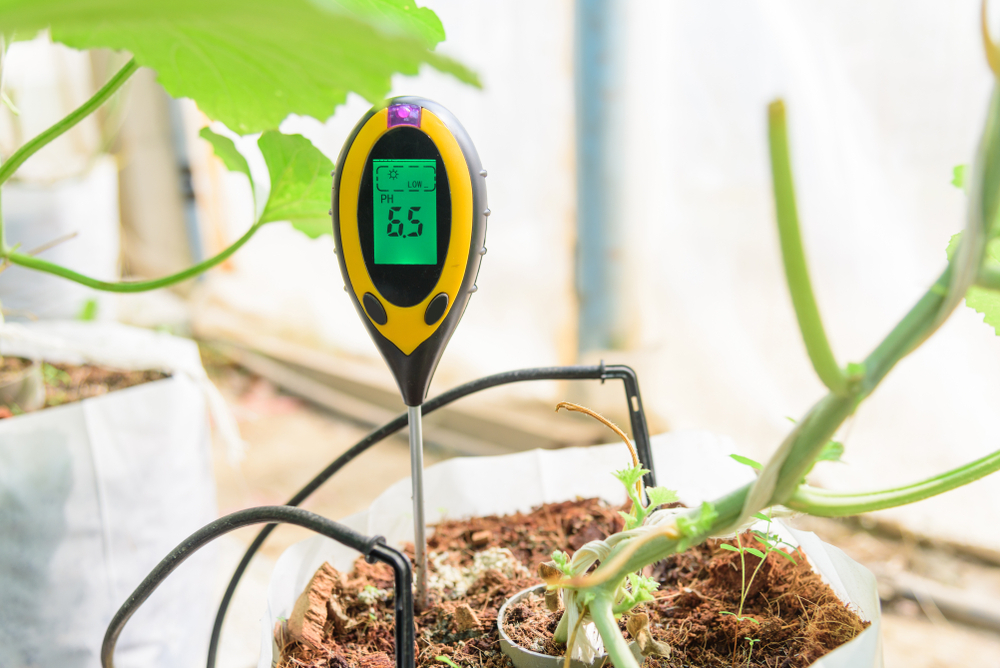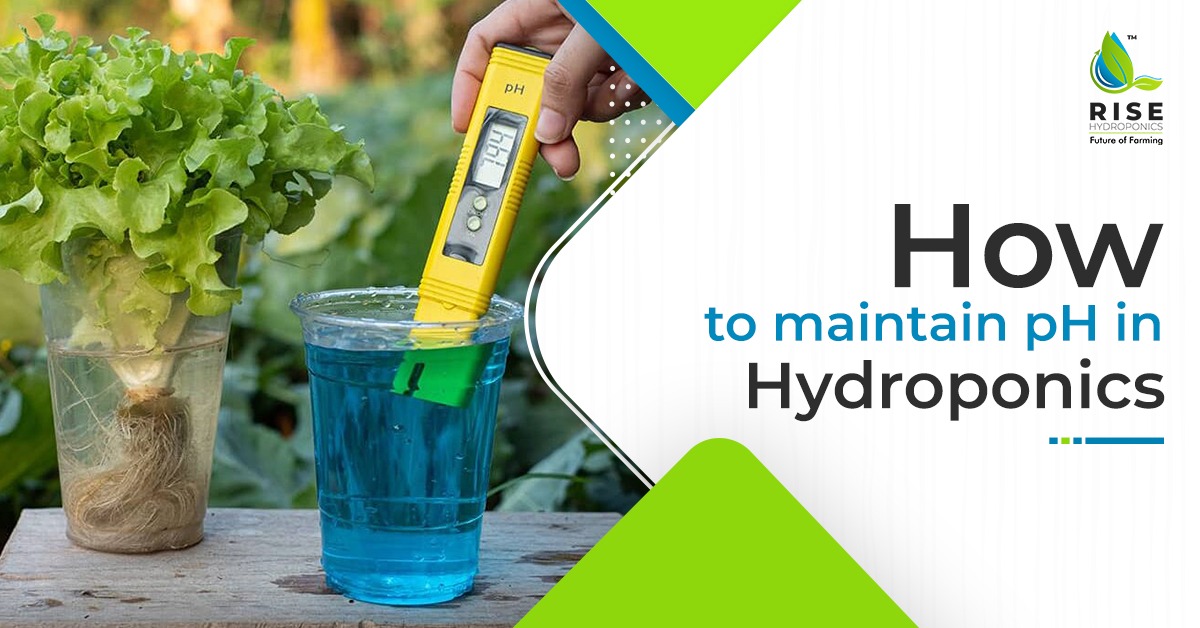Precision is the buzzword for hydroponics farming. The plants’ health in a growing system depends on factors such as humidity, EC, pH, crop selection, and design. All these parameters have a range in which they have to be kept to derive optimal results from the plants.
In fact, if you take hydroponics farming training in India, most of the questions you will receive will be on pH. So, we decided to write a blog on it. In this post, we will discuss pH, precisely the nutrient solution’s pH in Hydroponics.
What is pH?

So what do you think pH is? Potential hydrogen ions is the full form of pH. This number indicates whether a solution is alkaline or acidic. It is measured on a 0-14 scale where seven is neutral, which is the pH of water, anything above 7 is alkaline, and anything less than 7 is acidic.
Keep in mind that a pH scale is logarithmic. A pH of 5 will be ten times more acidic than pH six though the value denotes an increase by only one. In small hydroponic systems, you can often overlook the pH levels if you are more focused on problems related to plant pathogen, avoiding algae, balancing nutrients, TDS level, or electrical conductivity.
However, if you overlook the pH control, it can pose a danger to your plants, especially those plants that depend on water supplies with a higher alkalinity rate. Keep in mind that nutrient solution’s pH plays a critical role in determining essential nutrient ions’ uptake rate.
Types of pH ranges
Maintaining hydroponics pH level is an important task. That is because plants you grow through Hydroponics have a different optimal level of pH that differs from the plants that grow in soil. Hence, soilless gardeners have to be careful when applying pH recommendations for crops grown in soil to those that grow in a hydroponics setup.
So, what do new do? We follow a range. The most commonly grown hydroponic crops have an optimal pH range of 5.5-6.5. In Hydroponics, you have to maintain the right growth conditions for plants. To present the optimal pH, you must acquaint yourself with some introductory chemistry. Yes, it can be intimidating, if you did not pursue science in high school. But, fret not! We are hereby your side to explain everything.
There is unexplainable importance of pH in Hydroponics. Commercial growers use a narrower range of 5.6-6 for most crops due to automatic controllers. But, remember that optimal acidic pH range for hydroponic crops is crucial as it affects uptake and availability of essential plant nutrients and solubility. If pH drifts past 7, plant uptake of some of the nutrients becomes less efficient. For instance, plants become deficient in iron.
The best pH for Hydroponics is slightly acidic as the values range from 5.5 to 6.5. However, the optimal pH range for the availability of nutrients somewhat varies from one plant to another. Hence, you must consult a pH chart and use separate nutrient solution reservoirs for plant groups with similar pH needs.
Many veggies and fruits like tomatoes, squash, beans, apples, and melons grow well in the optimal pH range. All of these fruits and veggies prefer a value in this range of 5.5-6. But, blueberries need a more acidic and lower pH, preferably in the range of 4.0-5.0. Therefore, it is a great idea to use separate nutrient reservoirs for plants with identical pH ranges. Some hydroponic crops have an extensive optimal pH range. Pumpkin, for instance, thrives well at a pH of 5.5-7.5. Peas, onions, and kale prefer a pH range of 6.0-7. Mint plants tip the scale at a pH range of 7.0-8.0.
Why do pH levels undergo changes in hydroponics systems?

There are several factors that lead to changes in the pH levels. When the nutrient solution amount falls under one gallon, the solution becomes a lot more concentrated. That is because nutrients are absorbed by plants thus causing a fluctuation in pH levels. Hence, you must monitor the levels, test the reservoir’s pH, and keep the reservoir filled.
Both organic and inorganic matter can also affect the pH levels. For instance, inorganic growth media and gravel often act as a cushion. These both can cause a rise in the media-based systems’ pH levels. To get an accurate reading, you must always test the reservoir’s pH solution besides the leachate (the solution that drains from bags or beds).
Bacteria and algae are primary organic matter types that influence pH levels. If pH levels increase in the morning and decrease in the day, algae may be the reason for that. Algae absorb the acidic CO2 during the day hours which hence the pH levels rise during the day but fall by sunset.
Did you know that bacteria from the root disease cause the pH levels to drop dramatically? Well, the decomposition of diseased roots causes bacteria to release acids into the hydroponics solution hence pH levels fluctuate.
Problems if pH is not maintained properly
Most plants have some level of tolerance for pH imbalance. But, you have to maintain the correct pH level hydroponics because a wrong pH affects nutrient availability for the growing plants. A pH level that is too alkaline or too acidic prevents nutrients and can cause deficiencies. As a result, you will cultivate lower quality crops and may even experience loss of crops. That means your plant will not be able to access a group of nutrients or a specific nutrient from a growth medium.
Here is a round-up of the problems that surface if pH is not maintained ideally.
- You can identify a nutrient lockout by visible differences in plants, including yellowing leaves, lifelessness, and stunted growth.
- Other effects can typically show up as iron and calcium deficiency to the new foliage. With degraded calcium and iron levels, interveinal chlorosis takes place on the foliage, leaves start cupping, and tips burn; which in turn causes crop and economic losses.
Keep in mind that a nutrient lockout situation hinders the plant from taking up already present nutrients. But, if you want to grow healthy and strong plants, your plants need the proper nutrients.
Hence, you must identify the problem area. To check the pH and encourage growth, flush the growth media. You can do that by adding pure water devoid of any other additives. Use twice the amount of water as the growth media and keep flushing within the first three hours of the first flushing.
We have other tips too. How about getting hold of tools like pH meter, pH down Hydroponics, and pH up to measure the nutrient solution’s pH. If you find the pH levels too high, but the plant requires acidic conditions, you can use a mix of ammonium nitrate and vinegar to lower it.
But, if you need an alkaline condition, you can use calcium salt to enhance the pH values. However, if you are sure of what pH levels your plants can thrive under, maintain a general pH range of 5.5-7.
We recommend getting a liquid test kit or test strip if you cannot access a digital pH meter. No matter what tool you use, we recommend conducting regular tests and adjusting the nutrient levels. Keep daily records and keep adding products to measure the pH change until you achieve the desired hydroponics pH level.
Some examples of pH of different crops
- Basil can thrive in a pH range of 5.5-6.5
- Broccoli can thrive well in a pH range of 6.0-6.5
- Cucumber can thrive well in a pH range of 6.5-7
- Eggplant requires a pH range of 5.5-6.5
- Cauliflower requires a pH range of 6.0-7.0
- Bell peppers require a pH range of 6.0-6.5
- Mint requires a pH range of 5.5-6.0
- Zucchini can thrive well at a pH of 6.0
- Tomatoes can thrive well in a pH range of 5.5-6.5
Conclusion
It would be best if you managed the optimal pH range in hydroponics farming. That is because it directly influences the way plants to absorb nutrients. The pH not only affects the absorption rate of nutrients rather, but can also be used to decrease, increase, and uptake of some specific nutrients.
Adjusting pH and measuring it in a nutrient solution is a quick and straightforward process. Hence you have to get hold of the best pH adjusting products and pH testing tools from retailers and see what fits best for the different setups.
Keeping the pH within an ideal range means plants will have access to a full menu of essential nutrient ions for optimal productivity and growth. Remember, that if you maintain a correct pH, your hydroponics garden will thrive wonderfully, and the plants will bloom instead of withering away.

